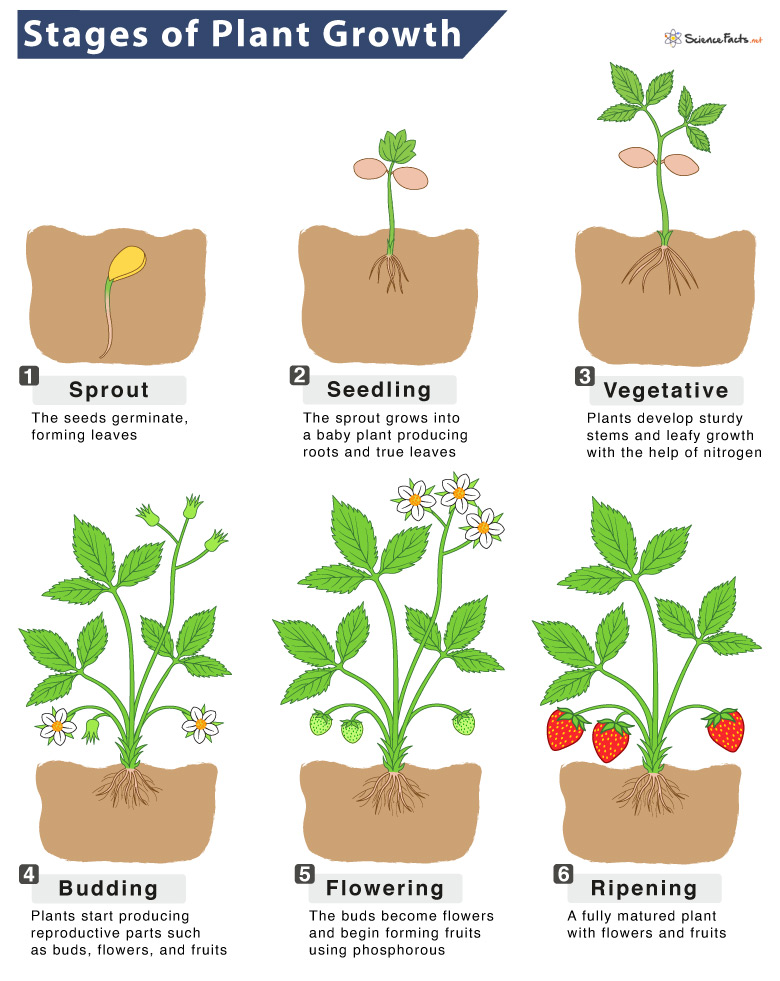Plant Growth
Plant growth is an irreversible increase in their size, mostly in length. Most plants grow throughout their life. As plants are multi-cellular organisms, they grow in two ways – cell growth and cell division. Cell growth increases the cell size, while cell division increases the cell number. With growth, the cells become specialized into different types, assuming specific functions.
Factors Affecting Plant Growth
1. Light
Sunlight provides the energy needed to convert water and carbon dioxide into food (carbohydrates). This process of producing food is called photosynthesis. Photosynthesis is directly proportional to the availability of sunlight. The rate of photosynthesis increases with the light intensity.
However, for each plant species, there is a fixed light intensity after which the rate of photosynthesis becomes stagnant. Photosynthesis contributes to plant growth by providing the energy needed to form new cells and repair damaged cells.
2. Water (Moisture)
It is one of the raw materials needed for photosynthesis. The availability of moisture in the soil or water underground is thus crucial for the synthesis of food.
3. Carbon dioxide
Photosynthesis also requires carbon dioxide as the other raw material apart from water. Carbon dioxide enters through stomata, which open in the morning, close in the afternoon, reopen in the late afternoon, and shut down during the evening.
Apart from the above factors, plant growth is also dependent on conditions such as temperature, the availability of essential nutrients, the pH of the soil, and the space to grow. These act as limiting factors since their availability play a crucial role in their growth. Phosphorus and nitrogen are minerals that act as limiting nutrients for plant growth.
How to Measure Plant Growth
Plant growth can be measured in four different ways:
- Measuring the plant height
- Measuring the leaf size
- Calculating the growth rate with fresh plants
- Calculating the growth rate with dried plants
How Plants Grow
Meristem, a type of tissue consisting of undifferentiated cells, is the key to all plant developments. Apical meristems are located at the apex or tip of roots and buds. They help roots and stems increase in length, allowing flowers and leaves to perform cell division.
Apical meristems differentiate into the three main types of meristem tissue, forming three types of tissues. Protoderm produces epidermis, ground meristem produces ground tissue, and procambium produces xylem and phloem.
Primary Growth
The increase in length or height of a plant through an increase in shoot and root length is called primary growth. It occurs due to cell division in the shoot and root apical meristems. The epidermis, ground tissue, xylem, and phloem are considered primary meristem because they are involved in the primary growth of plants.
Secondary Growth
On the other hand, when a plant grows in diameter, it is called secondary growth, and the meristems involved in such growth are called secondary meristems. Secondary growth is identified by an increase in thickness or girth of the plant. It is the result of cell division in the lateral meristem. Vascular cambium and cork cambium are two types of secondary meristems.
Woody plants undergo both primary and secondary growths. The vascular cambium produces xylem at the center of the stem or root and phloem to the outside. In contrast, the cork cambium is found between the epidermis and the phloem. It replaces the epidermis of roots and stems with bark.
Herbaceous plants mostly undergo primary growth, with almost no secondary growth or increase in thickness. Secondary growth is noticeable in woody plants; it is found in some dicots but is rare in monocots.
Some parts, such as stems and roots, continue to grow indeterminate throughout a plant’s life. Other parts, such as leaves and flowers, exhibit determinate growth, which ceases when a plant part reaches a particular size.
Different Stages of Plant Growth
1. Sprout
It is the initial stage of plant growth. During this period, the seeds germinate, forming leaves that are different from the true leaves of a plant. The seeds contain all the nutrients required for germination. Depending on the type of seed, sprouting can take several weeks.
2. Seedling
During this period, sprouts grow into a baby plant producing roots and true leaves that are smaller versions of the leaves found in mature plants. A supply of well-balanced nutrients helps the seedling to grow fast.
3. Vegetative
Plants in this stage develop sturdy stems and green leafy growth. Nitrogen, the essential component of chlorophyll, plays a crucial role during this phase.
4. Budding
It is the transition stage in plants during which plants shift from green leafy to the more sturdy form, preparing to produce reproductive parts such as buds, flowers, and fruits. Phosphorus is vital during this stage, providing nutrients to promote stem and leaf growth and stimulating buds to bloom.
5. Flowering
During this stage, buds become flowers, and fruiting plants begin forming fruit. The role of phosphorous becomes prominent during this stage, offering significant support for flowering.
6. Ripening
It is the final stage of plant growth. The plant is fully mature and no longer needs nitrogen or phosphorous. Flowers and fruit need just water devoid of nutrients (flushing) for a week or two to use up all the nutrients they have previously absorbed.
-
References
Article was last reviewed on Friday, February 3, 2023




